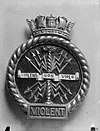Service history
In November 1917, Violent was assigned to the 13th Destroyer Flotilla [4] in the Grand Fleet. [5]
On 19 July 1918, Violent participated in history′s first attack by aircraft launched from the flight deck of an aircraft carrier, when she operated in the North Sea in support of a strike by Royal Air Force Sopwith 2F.1 Camel fighters from the aircraft carrier HMS Furious against the Imperial German Navy Zeppelin dirigible sheds at Tondern, Germany (today Tønder, Denmark) in what became known as the Tondern raid. Returning from the strike, Camel pilot Captain William F. Dickson, who had decided he would not be able to return to Furious, sighted Violent– the first British warship he encountered during his return flight – and circled her before ditching his aircraft in the sea. Violent recovered him, [6] and he went on to become a Marshal of the Royal Air Force, [7] Chief of the Air Staff, [8] and Chief of the Defence Staff. [9] [10]
Violent recommissioned at Chatham Dockyard on 15 October 1920. [11] In 1921, she joined the light cruisers HMS Caledon, Castor, Cordelia, and Curacoa and the destroyers HMS Vanquisher, Vectis, Venetia, Viceroy, Viscount, Winchelsea, and Wolfhound in a Baltic cruise, departing the United Kingdom on 31 August 1921, crossing the North Sea and transiting the Kaiser Wilhelm Canal to enter the Baltic. The ships called at Danzig in the Free City of Danzig; Memel in the Klaipėda Region; Liepāja, Latvia; and Riga, Latvia. The ships sighted a naval mine at the entrance to the harbor as they approached Tallinn, Estonia, on 17 September 1921, and Violent, ordered to sink it, detonated it with gunfire while the other ships waited to proceed. The ships then pulled into Tallinn for a port call and went on to visit Helsinki, Finland; Stockholm, Sweden; Copenhagen, Denmark; Gothenburg, Sweden; and Kristiania, Norway, before crossing the North Sea and ending the voyage at Port Edgar, Scotland, on 15 October 1921. [12]
Violent recommissioned at Rosyth on 11 March 1924. By March 1925 she was operating as part of the 9th Destroyer Flotilla in the Atlantic Fleet. [13] She recommissioned with a reserve crew on 23 November 1925. [14] She recommissioned at the Nore on 10 March 1927. [15] and again on 15 November 1927 for the Maintenance Reserve at Rosyth. [16]
Final disposition
After World War I, the United Kingdom received the passenger liner SS Bismarck from Germany in 1920 as a war reparation, and she was sold to the White Star Line, later the Cunard White Star Line, in which she served as RMS Majestic. In 1936, Cunard White Star retired Majestic and sold her to Thos. W. Ward for scrapping, but because of legal obligations imposed under the agreement transferring Majestic to the United Kingdom as a war prize, the British government instead took control of Majestic and assigned her to the Royal Navy. To pay Thos. W. Ward for Majestic, the Royal Navy agreed to transfer 24 old destroyers with a combined scrap value equivalent to that of Majestic to Thos W Ward for scrapping. Violent was among these, and her transfer to Thos W Ward took place on 8 March 1937. She was scrapped at Inverkeithing, Scotland. [1]
In December 1938, the Royal Navy offered interested parties a chance to apply to purchase Violent′s ship's bell, along with the bells of a number of other ships, encouraging applicants to state any special attachment or claim they had to the bell. [17]

HMS Magnificent was one of the nine Majestic-class pre-dreadnought battleships of the Royal Navy. She entered service in late 1895 with the Channel Fleet, remaining with the fleet through its subsequent reorganisation into the Atlantic Fleet. In 1905, an explosion caused the deaths of 18 men but she remained in service until 1906, after which she underwent a refit. She served with the Home Fleet for most of her pre-war service.

HMS Castor was one of the Cambrian subclass of the C class of light cruisers. She saw service during the First World War and the Russian Civil War.

The fourth HMS Comus was a C-class light cruiser of the Royal Navy that saw service in World War I. She was part of the Caroline group of the C class.
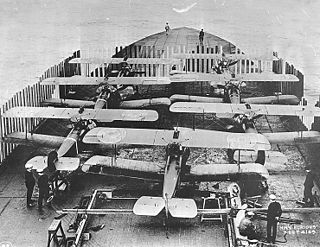
The Tondern raid or Operation F.7, was a British bombing raid by the Royal Navy and Royal Air Force against the Imperial German Navy airship base at Tønder, Denmark, then a part of Germany. The airships were used for the strategic bombing of Britain. On 19 July 1918, seven Sopwith Camels took off from HMS Furious, a converted battlecruiser, in the first attack in history by aircraft from an aircraft carrier. For the loss of one man and several aircraft, the British destroyed Zeppelins L 54, L 60 and a captive balloon.

HMS Seafire was an S-class destroyer built for the Royal Navy during the First World War. She saw service during the Allied intervention in the Russian Civil War. The ship was sold for scrap in 1936.

The fourth HMS Cleopatra was a C-class light cruiser of the Royal Navy that saw service during World War I and the Russian Civil War. She was part of the Caroline group of the C class.

HMS Westminster was a W-class destroyer of the Royal Navy. She was the first ship to bear the name. Launched in 1918, she served through two World Wars, and survived both to be sold for scrap in 1947.

HMS Valkyrie was a First World War V-class flotilla leader of the Royal Navy. She was one of two destroyers ordered in July 1916 from William Denny & Bros. Ltd shipyard under the 9th Order for Destroyers of the Emergency War Program of 1916–17. She was originally to be called HMS Malcolm but was renamed before being completed. The name Malcolm was later assigned to another destroyer leader.
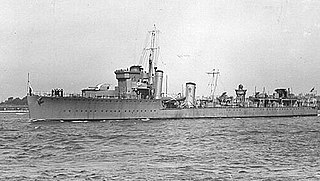
HMS Whitley (L23), ex-Whitby, was a W-class destroyer of the British Royal Navy that saw service in the British campaign in the Baltic Sea against Bolshevik forces during the Russian Civil War and in the early months of World War II.

The fifth HMS Valorous, ex-HMS Montrose, was a V-class flotilla leader of the British Royal Navy that saw service in World War I, the Russian Civil War, and World War II.

The second HMS Vanity was a V-class destroyer built for the Royal Navy during World War I that saw service in World War II.

HMS Vectis (D51) was a V-class destroyer of the British Royal Navy that saw service in World War I and the Russian Civil War.

HMS Venturous (D87) was a V-class destroyer of the British Royal Navy that saw service in World War I.

The first HMS Walrus (D24) was a W-class destroyer of the British Royal Navy that saw service in the final months of World War I.
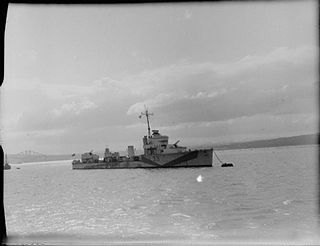
HMS Vivien (L33) was a V-class destroyer of the British Royal Navy that saw service in World War I and World War II.

HMS Watchman was a W-class destroyer of the British Royal Navy that saw service in the final months of World War I, in the Russian Civil War, and in World War II.

HMS Chevron was a C-class destroyer of the Royal Navy that was in service from August 1945 to the 1960s. She was scrapped in 1969.

HMS Southdown was a Type I Hunt-class destroyer of the Royal Navy which served in World War II. She was scrapped in 1956.
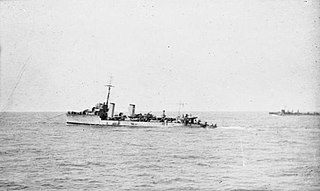
HMS Shakespeare was a Thornycroft type flotilla leader of the British Royal Navy. She was built by J I Thornycroft from 1916 to 1917 as the lead ship of her class, launching in July 1917 and completing in October 1917.
HMS Spenser was a Thornycroft type flotilla leader of the British Royal Navy. She was built by J I Thornycroft from 1916 to 1917 as the lead ship of her class, launching in September 1917 and completing in December that year.
This page is based on this
Wikipedia article Text is available under the
CC BY-SA 4.0 license; additional terms may apply.
Images, videos and audio are available under their respective licenses.
